| June 30, 2008 |  |
MarsDaily Advertising Kit |
| Previous Issues | Jun 29 | Jun 27 | Jun 26 | Jun 25 | Jun 24 |
100 years on, mystery shrouds massive 'cosmic impact' in Russia Paris (AFP) June 29, 2008
Paris (AFP) June 29, 2008A hundred years ago this week, a gigantic explosion ripped open the dawn sky above the swampy taiga forest of western Siberia, leaving a scientific riddle that endures to this day. A dazzling light pierced the heavens, preceding a shock wave with the power of a thousand atomic bombs which flattened 80 million trees in a swathe of more than 2,000 square kilometres (800 square miles). Even ... more NASA's Phoenix Mars Lander Puts Soil In Chemistry Lab  Tucson AZ (SPX) Jun 27, 2008
Tucson AZ (SPX) Jun 27, 2008NASA's Phoenix Mars Lander placed a sample of Martian soil in the spacecraft's wet chemistry laboratory today for the first time. Results from that instrument, part of Phoenix's Microscopy, Electrochemistry and Conductivity Analyzer, are expected to provide the first measurement of the acidity or alkalinity of the planet's soil. The analysis of this soil sample and others will help research ... more Phoenix Returns Treasure Trove For Science  Pasadena CA (SPX) Jun 27, 2008
Pasadena CA (SPX) Jun 27, 2008NASA's Phoenix Mars Lander performed its first wet chemistry on Martian soil flawlessly yesterday, returning a wealth of data that for Phoenix scientists was like winning the lottery. "We are awash in chemistry data," said Michael Hecht of NASA's Jet Propulsion Laboratory, lead scientist for the Microscopy, Electrochemistry and Conductivity Analyzer, or MECA, instrument on Phoenix. ... more Martian Soil Good Enough For Asparagus  by Jean-Louis Santini
by Jean-Louis SantiniWashington DC (AFP) Jun 27, 2008 Martian dirt is apparently good enough for asparagus to grow in, NASA scientists said Thursday, as they announced the results of a soil analysis collected by the US Phoenix Mars lander. "There is nothing about the soil that would preclude life. In fact it seems very friendly," said Samuel Kounaves, the project's lead chemist at the University of Arizona in ... more Giant Impact Explains Mars Dichotomy  Santa Cruz CA (SPX) Jun 26, 2008
Santa Cruz CA (SPX) Jun 26, 2008The dramatic differences between the northern and southern hemispheres of Mars have puzzled scientists for 30 years. One of the proposed explanations--a massive asteroid impact--now has strong support from computer simulations carried out by two groups of researchers. Planetary scientists at the University of California, Santa Cruz, were involved in both studies, which appear in the June 2 ... more |
mars-general
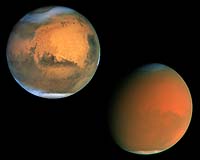 mars-life 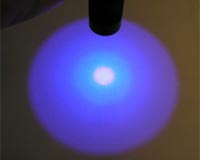 mars-phoenix 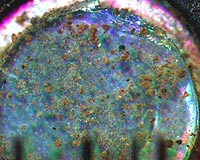 |
 Washington (AFP) June 20, 2008
Washington (AFP) June 20, 2008Scientists rejoiced Friday after the Phoenix Mars lander confirmed their long-held belief that ice is hiding under the surface in the Red Planet's northern region. The lander's robotic arm started digging trenches into Martian soil after touching down near the planet's north pole on May 25, revealing a white substance that scientists had said could be either salt or ice. Phoenix flexed ... more Frozen Water Confirmed On Mars  Pasadena CA (SPX) Jun 23, 2008
Pasadena CA (SPX) Jun 23, 2008Scientists relishing confirmation of water ice near the surface beside NASA's Phoenix Mars Lander anticipate even bigger discoveries from the robotic mission in the weeks ahead. "It is with great pride and a lot of joy that I announce that we have found proof that this hard bright material is really water ice and not some other substance," said Phoenix Principal Investigator Peter Smith of ... more Mars Science Is A Sublime Affair For Phoenix Lander  Tucson AZ (JPL) Jun 23, 2008
Tucson AZ (JPL) Jun 23, 2008Dice-size crumbs of bright material have vanished from inside a trench where they were photographed by NASA's Phoenix Mars Lander four days ago, convincing scientists that the material was frozen water that vaporized after digging exposed it. "It must be ice," said Phoenix Principal Investigator Peter Smith of the University of Arizona, Tucson. "These little clumps completely disappearing ... more Harris Selected For Potential New NASA Space Suit Communications System  Melbourne FL (SPX) Jun 23, 2008
Melbourne FL (SPX) Jun 23, 2008Harris has been selected for a potential seven-year, $58 million contract to provide the RF communications/navigation system for the next-generation space suit supporting NASA's Constellation program. Harris is a member of the Oceaneering International, Inc. team. The primary goals of NASA's Constellation Program are to maintain an American presence in low Earth orbit, to return to the ... more |
mars-phoenix
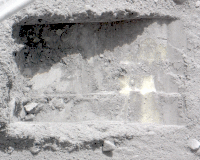 mars-phoenix 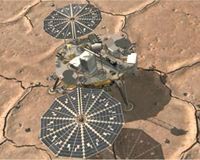 radar 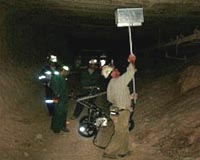 |
 Pasadena CA (JPL) Jun 19, 2008
Pasadena CA (JPL) Jun 19, 2008Opportunity finally escaped the Martian sand and backed up onto solid rock inside "Victoria Crater." Driving backward on Martian day, or sol, 1557 (June 10, 2008), the rover successfully moved the last of its six wheels up over a rocky ledge. The successful maneuver freed Opportunity to follow another route that will bring the rover closer to the cliff known as "Cape Verde." From there ... more NASA Mars Lander To Dig As Team Probes Flash Memory  Tucson AZ (SPX) Jun 19, 2008
Tucson AZ (SPX) Jun 19, 2008NASA's Phoenix Mars Mission generated an unusually high volume of spacecraft housekeeping data on Tuesday causing the loss of some non-critical science data. Phoenix engineers are analyzing why this anomaly occurred. The science team is planning spacecraft activities for Thursday that will not rely on Phoenix storing science data overnight but will make use of multiple communication relays ... more Phoenix Makes First Trench In Science Preserve  Tucson AZ (SPX) Jun 19, 2008
Tucson AZ (SPX) Jun 19, 2008NASA's Phoenix Mars Lander began digging in an area called "Wonderland" early Tuesday, taking its first scoop of soil from a polygonal surface feature within the "national park" region that mission scientists have been preserving for science. The lander's Robotic Arm created the new test trench called "Snow White" on June 17, the 22nd Martian day, or sol, after the Phoenix spacecraft landed ... more NASA Phoenix Lander Bakes Sample As Arm Digs Deeper  Tucson AZ (SPX) Jun 18, 2008
Tucson AZ (SPX) Jun 18, 2008One of the ovens on NASA's Phoenix Mars Lander continued baking its first sample of Martian soil over the weekend, while the Robotic Arm dug deeper into the soil to learn more about white material first revealed on June 3. "The oven is working very well and living up to our expectations," said Phoenix co-investigator Bill Boynton of the University of Arizona, Tucson. Boynton leads the ... more
|
mars-phoenix
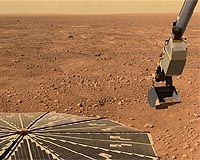 mars-phoenix 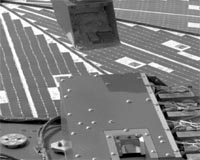 mars-phoenix 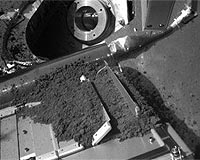 |
| Previous Issues | Jun 29 | Jun 27 | Jun 26 | Jun 25 | Jun 24 |
| The contents herein, unless otherwise known to be public domain, are Copyright 1995-2007 - SpaceDaily. AFP and UPI Wire Stories are copyright Agence France-Presse and United Press International. ESA Portal Reports are copyright European Space Agency. All NASA sourced material is public domain. Additional copyrights may apply in whole or part to other bona fide parties. Advertising does not imply endorsement, agreement or approval of any opinions, statements or information provided by SpaceDaily on any web page published or hosted by SpaceDaily. Privacy statement |